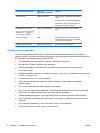
●
Creating strong password policies
● Addressing regulatory security mandates
Protecting against targeted theft
An example of this type of incident would be the targeted theft of a computer or its confidential data
and customer information. This can easily occur in open office environments or in unsecured areas.
The following features help protect the data if the computer is stolen:
● The pre-boot authentication feature, if enabled, helps prevent access to the operating system.
See the following chapters:
◦
Password Manager for HP ProtectTools on page 25
◦
Embedded Security for HP ProtectTools on page 49
◦
Drive Encryption for HP ProtectTools on page 29
●
DriveLock helps ensure that data cannot be accessed even if the hard drive is removed and
installed into an unsecured system.
●
The Personal Secure Drive feature, provided by the Embedded Security for HP ProtectTools
module, encrypts sensitive data to help ensure it cannot be accessed without authentication.
See the following chapter:
◦
Embedded Security for HP ProtectTools on page 49
●
Computrace can track the computer's location after a theft. See the following chapter:
◦
Computrace for HP ProtectTools on page 57
Restricting access to sensitive data
Suppose a contract auditor is working on site and has been given computer access to review
sensitive financial data; you do not want the auditor to be able to print the files or save them to a
writeable device such as a CD. The following feature helps restrict access to data:
Device Access Manager for HP ProtectTools allows IT managers to restrict access to writeable
devices so sensitive information cannot be printed or copied from the hard drive onto removable
media. See
Device class configuration (advanced) on page 54.
ENWW Achieving key security objectives 7


















